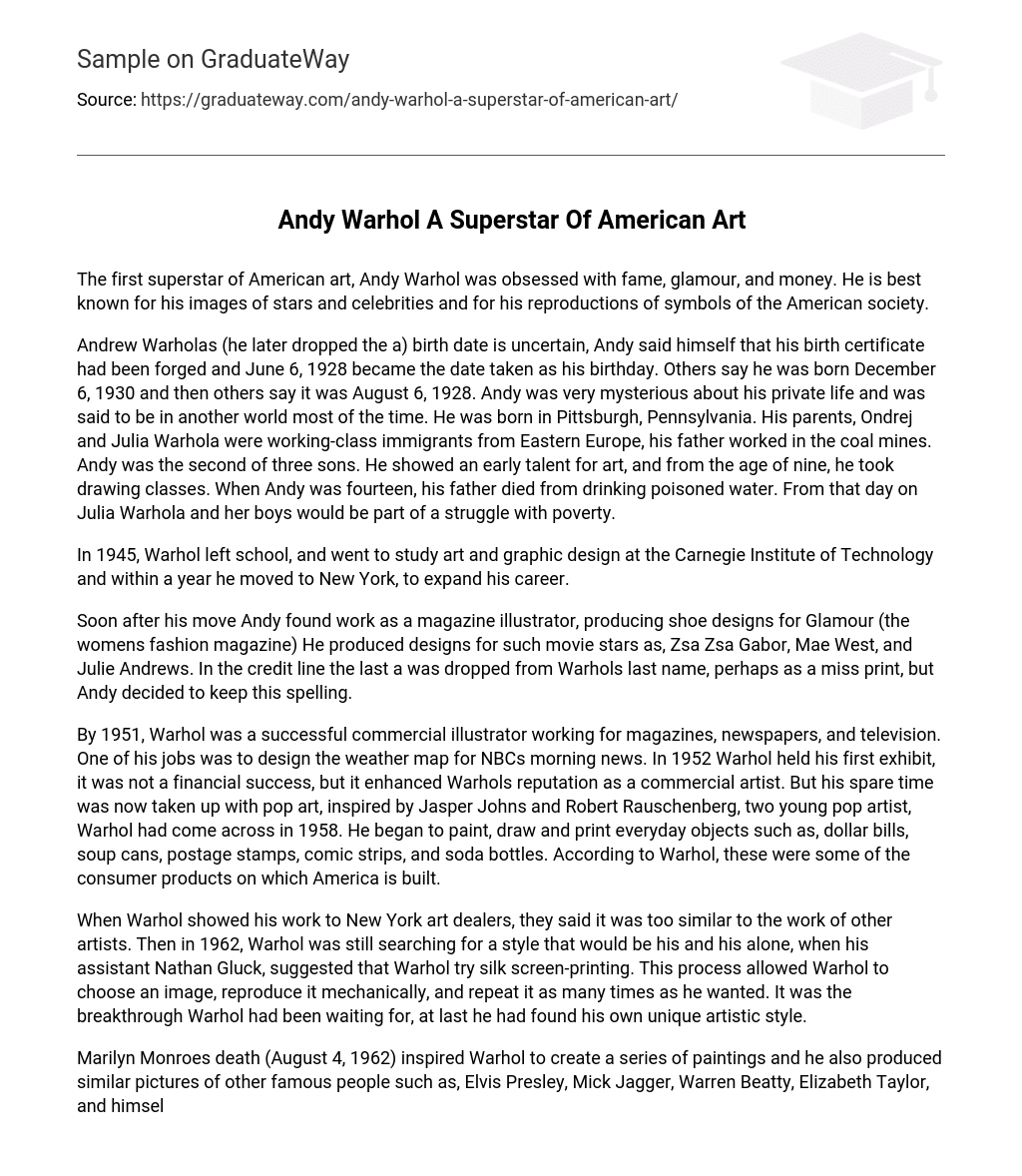Andy Warhol, the first American art sensation, had a deep fixation on fame, glamour, and financial success. He received widespread acclaim for his portrayals of famous figures and celebrities, as well as his reproduction of iconic symbols from American culture.
Andy Warhol, formerly known as Andrew Warholas, was born on an uncertain date. Despite claiming that his birth certificate had been forged, June 6, 1928 was accepted as his official birthday. However, conflicting reports suggest he may have been born on December 6, 1930 or August 6, 1928.
Warhol was highly secretive about his personal life and often appeared disconnected from reality. Born in Pittsburgh, Pennsylvania to Ondrej and Julia Warhola – immigrants from Eastern Europe who worked in the coal mines – Andy was the second of three sons.
Demonstrating artistic talent at a young age, he began taking drawing classes at nine years old. Tragically, when he turned fourteen, his father passed away after consuming poisoned water. From then on, Julia Warhola and her sons struggled with poverty.
After leaving school in 1945, Warhol decided to pursue his passion for art and graphic design by enrolling in the Carnegie Institute of Technology. In just one year, he made the decision to move to New York in order to advance his career.
After Andy moved, he swiftly secured a position as a magazine illustrator. His task was to design shoes for Glamour, a women’s fashion magazine. Notably, his creations were worn by renowned actresses such as Zsa Zsa Gabor, Mae West, and Julie Andrews. Interestingly, the credits featured a typo omitting the last “a” in Warhol’s surname. Despite it being an apparent error, Andy chose to embrace and retain this modified spelling.
By 1951, Andy Warhol was already established in his career as a successful commercial illustrator, working for various media outlets like magazines, newspapers, and television. Among his tasks was creating the weather map for NBC’s morning news. In 1952, Warhol showcased his first exhibition, which may not have brought him financial success, but it did contribute to building his reputation as a commercial artist. However, during his free time, Warhol became increasingly fascinated with pop art after encountering two emerging pop artists named Jasper Johns and Robert Rauschenberg in 1958. This newfound inspiration led Warhol to create paintings, drawings, and prints featuring everyday objects such as dollar bills, soup cans, postage stamps, comic strips, and soda bottles. Warhol believed that these consumer products were integral to the foundation of American culture.
When Warhol presented his artwork to art dealers in New York, they remarked that it bore resemblance to the works of other artists. However, in 1962, Warhol was still on a quest to find his own unique style. Nathan Gluck, one of his assistants, suggested that Warhol try silk screen-printing as an experiment. With this method, Warhol could choose an image, replicate it mechanically, and reproduce it according to his own preferences. This marked the crucial moment that Warhol had been eagerly awaiting as he finally discovered his exceptional artistic approach.
Following Marilyn Monroe’s death on August 4, 1962, Warhol drew inspiration and crafted a collection of paintings. In addition to capturing Marilyn Monroe’s likeness, he also portrayed other notable figures such as Elvis Presley, Mick Jagger, Warren Beatty, Elizabeth Taylor, and even himself.
Warhol initially exhibited his new work at the Ferus Gallery in Los Angeles and later at The Stable Gallery in New York in November 1962. These prints had a significant impact on the art world. By 1963, he started incorporating newspaper images into his artwork, expanding his subject matter. It is important to note that Warhol’s interest went beyond the glamorous aspects of celebrity culture; he also explored the harsh realities of contemporary life. However, Warhol claimed that his pieces had no social commentary or meaning. Furthermore, in 1963, he obtained an abandoned hat factory which became known as The Factory, emphasizing the mechanized nature of his artistic pursuits.
The silk screen method and Warhol’s increasing wealth allowed him to hire assistants, providing him with more time to explore various artistic avenues. These included experimenting with films, writing a novel titled “a,” producing his own play called “pork,” managing the rock band The Velvet Underground, and publishing Andy Warhol’s Interview magazine. By the late 1960s, Warhol became famous for his extravagant lifestyle at The Factory, which attracted both hangers-on and thrill-seekers. However, on June 3, 1968, Valerie Solanas—a thrill-seeker among these individuals—aggressively shot Warhol three times causing severe injuries. This incident deeply impacted Warhol’s artistic output and led to a complete halt in his work from 1969 to 1971.
Following a period of relaxation and informality, the factory experienced a significant change as it adopted a more professional and organized business model. During the 1970s, Warhol moved from The Factory to Manhattan with the aim of rejuvenating his artistic standing through the production of silk screen prints depicting Mao Tse-Tung, the leader of China.
Andy Warhol’s life ended in February 1987 after being admitted to New York Hospital for a Gall Bladder operation. Tragically, unexpected complications occurred and he died on February 22, 1987 at the age of 58.
Warhol was perceived by the public and the media as peculiar – some appreciated his artwork while others deemed it outright deceit. I personally appreciate his art for its unconventional nature; although simplistic, it possesses a profound realism. I also perceive Andy Warhol himself as an eccentric individual, mirroring the peculiarity of his art. It appears that he relished in his enigmatic lifestyle, and I am inclined to believe that he intentionally desired the world to view him as eccentric and abnormal – hence his choice of subject matter in his paintings.
Bibliography
- http://www2.lucidcafe.com/lucidcafe/gallery/warhol2.html
- http://www.sbu.ac.uk/~stafflag/andywarhol.html
- http://www.warholhockney.com/bio.html
- Honnef, Klaus. “Andy Warhol Benedikt Taschen Verlag GmbH Hohenzollerring. (1993)





